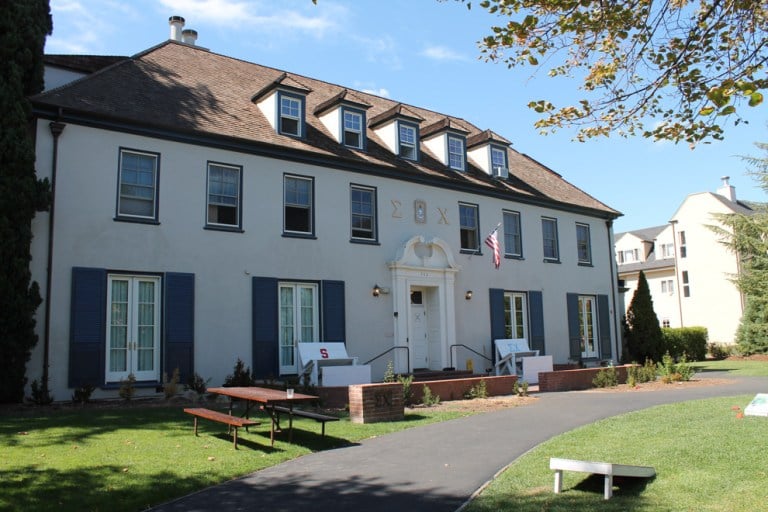As students, many of us have committed to addressing discrimination wherever and whenever it occurs. At 5 p.m. on October 21, 2022, at 550 Lasuen, the campus community will have an opportunity to commemorate an important moment in the history of the University in this regard.
In 1965, the Alpha Omega Chapter of Sigma Chi at Stanford gave a bid for membership to a 19-year old Black freshman: Keni Washington. Prior to pledging Washington, the National fraternity had placed the local chapter on notice. In a letter sent to Chapter alumni in late 1964, the National had been warned that the House was in crisis because it was “not free to pledge Negroes.” Upon pledging Washington, even after this strong warning, the Chapter’s National fraternity initially suspended the local chapter; the Chapter then voted to leave its National fraternity rather than oblige blatant racial exclusionary policies.
On April 13, 1965, the Stanford Daily reported the suspension as its lead story, quoting Chapter President Gary Kerns ‘65 who summed up the Chapter’s position: “… we will not give up the pledge to stay in the National ….”
Sigma Chi was 110 years old in 1965. Given the national policy, it is unlikely that an African-American student had ever been allowed membership nationally. Sigma Chi’s exclusionary policies were not alone among Greek or other student associations, and many groups’ exclusionary practices extended to other races and religion. In the 1960s, segregation and discriminatory practices were still rampant across the country, at all levels of our society.
Although it was commendable that these students were willing to abandon their National fraternity over this issue, what happened next is what stands out as the historical moment for the University. The students took a principled stand and thereby set in motion a chain of events that changed the racial exclusionary policies of student associations at all colleges and universities nationwide.
The New York Times began reporting on their efforts. Then, on July 27, 1965, America’s most popular weekly news magazine, Look Magazine, ran a 6-page photo story on the efforts of the Stanford students.
The students worked closely with the administration of the University, then led by President J.E. Wallace Sterling. The students were not familiar with dealing with national media, so professors joined in to help. These included Robert McAfee Brown, James T. Watkins IV and Victor Palmieri.
Montana Senator Lee Metcalf ‘36, himself a Stanford alum, took the Stanford issue to the floor of Congress in 1965, demanding a ruling on whether the fraternity’s behavior had violated the 1964 Civil Rights Act. By the end of 1965, United States Commissioner of Education Francis Keppel issued a directive that educational institutions that allowed segregation in their private student associations would lose federal funding and grants.
Commissioner Keppel’s directive forced universities to come into compliance or risk losing funding. As a result, millions of students, in all student associations, were able to freely associate.
Stanford’s Historic Sigma Chi House remains the only privately owned residence on campus, under a ground lease with the University. Their lease flows from the foresight of founder Jane Stanford who, in amendments to the Founding Documents, made clear her intent that in the “future administration of the Leland Stanford Jr. University” the University should “lease lots” for privately built student residences and declared that “the present provisions for leasing lots should be continued…”
Stanford’s Historic Sigma Chi House was built in 1938. Since a new ground lease was executed in 1976, the owners (alumni of the Chapter) estimate they have invested over $32 million dollars in the property, including the value of the House.
At 5 p.m., on October 21, the entire Stanford community is invited to 550 Lasuen to commemorate the members of the Classes of 1965, 1966 and 1967 who took this courageous stand and provided the leadership that has impacted multitudes of students in the intervening years.
There are only a few historically designated structures on this campus. The short list includes structures built by the founders (the Stanford Barn), a former U.S. President and his wife (Lou Hoover Henry House) and the residence of at least one professor. This commemoration is unique: it honors history created by the University’s students, many of whom will attend the event.
At a time when many of us are fighting to create a more equitable society, it is important to stop every once in a while and reflect on successes and victories in battles already won. This is one of them. It will instill an appreciation in all of us that a principled stand, by even a few committed students, can change the world.
Reunion weekend will be busy, but this commemoration on October 21, at 5 p.m., is a must-stop for your weekend agenda.
Adam Hussain is a sophomore majoring in Political Science with interests in tech policy and cybersecurity. In his free time, he enjoys biking and avidly discussing his hometown of Los Angeles.
